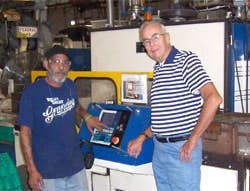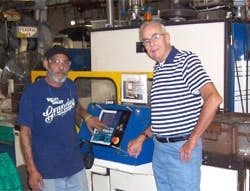Safety born out of sustainability
For a Connecticut firm that manufactures close-tolerance precision parts, environmental responsibility has evolved in the past 20 years from something imposed by regulators to a way of life the company embraces and celebrates as a key differentiator. Now the company positions itself as one that can meet or exceed all U.S. and European environmental standards, placing it at a distinct competitive advantage.
The catalyst for environmental change
Connecticut Spring and Stamping (CSS, www.ctspring.com) is a Farmington, Connecticut-based manufacturer of springs, metal stampings, fourslide/multislide/vertislide, and assemblies from both wire and sheet metal. After winding, bending, stamping, and grinding operations, many of the products must be cleaned and degreased before a final finish can be applied.
By the mid-1990s, the degreasing operations had become a financial and environmental burden. The 1960s-era vapor degreasers required purchasing huge quantities of expensive virgin tetrachloroethylene (perc). Regulations tightened permissible air emissions and made waste perc disposal much more costly. Concerns about the health implications of worker’s exposure to perc meant reducing emissions or installing a venting system.
Facing tightened air emission regulations, CSS made a serious effort to find alternatives, eventually deciding to purchase two state-of-the-art Pero (www.perocorp.com) Model 2501A batch vacuum degreasers with an in-line still to recover valuable perc from the unit’s waste stream. The improved design halved virgin perc purchases and cut vapor emissions by 70%. The fully-contained unit discharges no water, producing only a small chemical residue that’s processed in accordance with hazardous waste disposal regulations.
[pullquote]The turnkey system allowed CSS to change its hazardous waste generator status from large-quantity generator to small-quantity generator, which came with welcome reductions in overhead and regulatory requirements. Reduced tetrachloroethylene purchases netted savings of nearly $40,000 a year, and hazardous waste disposal costs were reduced by $7,500. In addition, CSS virtually eliminated air emissions. Finally, dramatically reduced odors removed the need for personal protective equipment or an exhaust system.
The results of the new system far exceeded expectations, and are seen by Chuck Thomas, CSS vice president of operations and environmental officer, as the single most significant factor that shifted the company’s thinking and set it on its current path of going above and beyond requirements to doing what is best from an environmental point of view.
“We knew our old equipment needed to be replaced,” says Thomas, “and we had a variety of lower-cost options, but we decided to go for this top-of-the-line system for the sake of our employees and the environment and to set us up for improved manufacturing processes to keep up with the times The results opened our eyes to the extended benefits of environmental compliance.”
In a final testament to the importance of the achievement, the Connecticut Department of Environmental Protection wrote a Pollution Prevention Study about the system in 1998, making CSS a veritable poster child for investing in environmental excellence.
Extended success
Chuck Thomas (left), vice president of operations and environmental officer, and Julien Nieves, machine operator, are part of CSS’s front line for sustainability and safety.
After its success with its foray into cutting-edge environmental equipment, CSS now goes over and above every existing Connecticut requirement, actively looking for an environmentally preferable alternative for every chemical or substance the plant uses. It’s been cited in numerous customer audits as being well ahead of other similar vendors in environmental compliance.
“We don’t ship anything that isn’t environmentally compliant, nor do we allow any chemical in the plant that’s dangerous to employees or hazardous,” says Thomas. “We don’t even allow samples into the plant without first doing a material-safety-data-sheet (MSDS) review.” Thomas explains that housing more hazardous substances increases the possibility of a spill or emissions to the air or land or exposure to workers. He gives the example of acetone, which isn’t allowed in the plant.
On a couple of occasions, the company turned away business when the customer insisted on using a particular hazardous chemical, rather than a suggested substitute. Overall, the company believes it gained more business than it lost by being so attuned to environmental and hazardous waste concerns. Thomas adds that CSS is always looking for newer and better options for chemical substitutions but is careful to ensure that new options are vetted thoroughly before being accepted for use.
According to Thomas, CSS used to require sewer permits to allow discharge of processed water into the sewer system, but now processed water is evaporated into clean steam. Also, sludge is no longer placed in the sewer system, but is removed by an environmental disposal firm.
In addition to the attention paid to hazardous material substitutions and the reduction in wastewater disposal and air emissions, Thomas conducts weekly and monthly audits for storm water runoff, spill prevention control, drum area inspection, and spill preparedness. Reuse and recycling of corrugated packaging materials also is an integral part of the facility’s operations.
As a certified trainer, Thomas educates 40 workers about annual hazardous waste materials certifications, including such topics as hazardous communications, solvent safety, hazardous waste management, spill response, and DOT security.
“We’re continually looking to the next advance in environmental compliance, which is becoming increasingly important to many Fortune 500 companies,” says Thomas. “In addition to U.S. rules, we comply with European Restriction of Hazardous Substances Directive (RoHS), as well as REACH (Registration, Evaluation, Authorisation and Restriction of Chemical substances) standards as part of our cost of doing business.”

